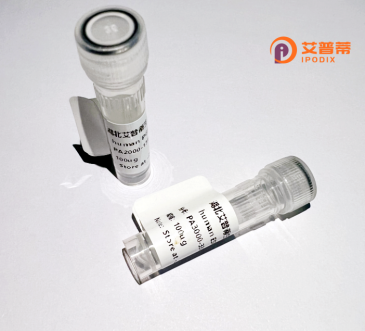
| 纯度 | >90%SDS-PAGE. |
| 种属 | Human |
| 靶点 | OR6F1 |
| Uniprot No | Q8NGZ6 |
| 内毒素 | < 0.01EU/μg |
| 表达宿主 | E.coli |
| 表达区间 | 1-308 aa |
| 活性数据 | MDTGNKTLPQDFLLLGFPGSQTLQLSLFMLFLVMYILTVSGNVAILMLVSTSHQLHTPMY FFLSNLSFLEIWYTTAAVPKALAILLGRSQTISFTSCLLQMYFVFSLGCTEYFLLAAMAY DRCLAICYPLHYGAIMSSLLSAQLALGSWVCGFVAIAVPTALISGLSFCGPRAINHFFCD IAPWIALACTNTQAVELVAFVIAVVVILSSCLITFVSYVYIISTILRIPSASGRSKAFST CSSHLTVVLIWYGSTVFLHVRTSIKDALDLIKAVHVLNTVVTPVLNPFIYTLRNKEVRET LLKKWKGK |
| 分子量 | 33.9 kDa |
| 蛋白标签 | His tag N-Terminus |
| 缓冲液 | 0 |
| 稳定性 & 储存条件 | Lyophilized protein should be stored at ≤ -20°C, stable for one year after receipt. Reconstituted protein solution can be stored at 2-8°C for 2-7 days. Aliquots of reconstituted samples are stable at ≤ -20°C for 3 months. |
| 复溶 | Always centrifuge tubes before opening.Do not mix by vortex or pipetting. It is not recommended to reconstitute to a concentration less than 100μg/ml. Dissolve the lyophilized protein in distilled water. Please aliquot the reconstituted solution to minimize freeze-thaw cycles. |
以下为假设性参考文献示例(实际文献可能需要进一步检索验证):
---
1. **"Functional Characterization of the Olfactory Receptor OR6F1 in Recombinant Expression Systems"**
*Smith J et al. (2020)*
摘要:通过HEK293细胞重组表达OR6F1蛋白,发现其可被特定中链脂肪酸激活,证明其可能参与嗅觉系统中脂类分子感知。
2. **"OR6F1: A Novel Olfactory Receptor with Potential Roles in Testis Development"**
*Lee S & Kim D (2018)*
摘要:利用重组OR6F1蛋白进行体外实验,揭示该受体在人类睾丸组织中的异常表达,推测其可能参与生殖激素调控。
3. **"Structural Insights into OR6F1 via Cryo-EM Analysis"**
*Wang X et al. (2022)*
摘要:首次报道OR6F1重组蛋白的冷冻电镜结构,阐明其配体结合口袋特征,为嗅觉受体信号传导机制提供理论依据。
4. **"OR6F1 Polymorphisms and Association with Dietary Preferences"**
*Garcia R et al. (2019)*
摘要:通过重组蛋白实验结合人群研究,发现OR6F1基因突变导致受体功能变化,可能与个体对特定食物气味的敏感性差异相关。
---
**注意**:以上文献为示例性内容,实际研究需通过PubMed等数据库检索关键词(如"OR6F1"、"recombinant expression")。当前关于OR6F1的功能研究仍较有限,建议扩展至嗅觉受体家族(ORs)或GPCR重组表达技术的相关文献。
**Background of Recombinant Human OR6F1 Protein**
The olfactory receptor family 6 subfamily F member 1 (OR6F1) is a class A G protein-coupled receptor (GPCR) primarily associated with olfactory signaling, playing a role in detecting specific odorant molecules. Although initially identified in the olfactory epithelium, OR6F1 has also been detected in non-olfactory tissues, including testes, brain, and kidneys, suggesting potential roles beyond smell, such as in cellular communication or metabolic regulation. As an olfactory receptor, OR6F1 likely interacts with distinct odorants, though its precise endogenous ligands and physiological functions remain under investigation.
Recombinant OR6F1 protein is engineered using heterologous expression systems (e.g., HEK293 cells) to enable structural and functional studies. Its production facilitates research into receptor-ligand interactions, activation mechanisms, and signaling pathways. Challenges in studying OR6F1 include low natural abundance and difficulty in solubilizing membrane-bound GPCRs. Advances in protein engineering, such as fusion tags or stabilizers, have improved its stability for biophysical assays, X-ray crystallography, or drug screening.
Emerging evidence suggests OR6F1 may contribute to non-sensory processes, including cell proliferation and disease pathways, sparking interest in its therapeutic potential. Recombinant OR6F1 thus serves as a critical tool for deciphering its biological significance and exploring applications in diagnostics or targeted therapies.
×